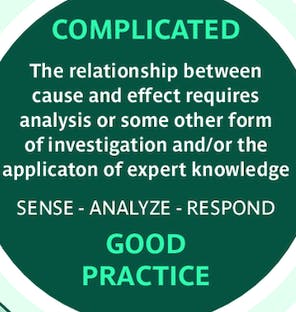Introduction
Software engineering and agile methodologies both rely on decision-making. Teams can utilise it to work through difficult situations, identify and resolve problems, and advance projects. The Cynefin Framework is a decision-making tool that can help individuals and organisations comprehend challenging situations and choose the best course of action.
What is the Cynefin Framework?
The Cynefin Framework was developed by the Cynefin Centre's founder and main scientist, Dave Snowden.
It is based on sense-making, which denotes taking in and interpreting our surroundings.
The framework is composed of five domains: simple, complicated, complex, chaotic, and disorder. Each domain has distinct characteristics and demands a diverse approach to decision-making.
For software engineering and agile processes to advance projects and manage complicated situations, decision-making is crucial. Teams can use the Cynefin Framework to determine the appropriate level of structure and process for a given circumstance.
What is the importance of decision-making in software engineering?
Making decisions is a crucial component of software engineering since it aids teams in navigating the challenging and dynamic world of software development.
Teams can use it to identify and rank the most crucial tasks, choose the best course of action, and make decisions that will eventually help the software development project succeed.
The capacity to gather, examine and evaluate data from a variety of sources, including user input, market trends, and technical breakthroughs, is necessary for effective decision-making. It also calls for the capacity to weigh several possibilities and assess the potential risks and trade-offs related to each.
Teams are able to take decisions as a result that are both efficient and effective and in line with the organization's aims and objectives.

Domains of Cynefin Framework
Simple/Clear domain: Cause-and-effect links are obvious in this area, and best practices can be used to identify solutions. It is carried out by the intuition of sensing, categorizing, and responding.

Example:
A software development project where the goal is to upgrade an existing software programme with a new button.
The relationships between causes and effects are obvious, and following best practises will reveal the answer.
The group can adhere to a predetermined set of guidelines, such as developing a new button design and incorporating it into the current codebase.
Complicated Domain: Cause-and-effect relationships in this area require expert study because they are not always clear. It is carried out by the intuition of sensing, analyzing, and responding.

Example:
A software development undertaking where the incorporation of an external payment gateway is necessary.
The cause and effect links call for professional study because they are not immediately clear. The group must weigh various factors, including security, price, and user experience.
Additionally, they must assess the risks and potential trade-offs related to each alternative.
Complex domain: cause-and-effect relationships are unknown, and solutions emerge through experimentation and learning. It is carried out by the intuition of probing, sensing, and responding.

Example:
A software development undertaking where the goal is to use AI to generate a new product.
Solutions come about through testing and learning since the cause and effect links are unknown.
Until they get the intended result, the team must rely on trial and error and continually test and iterate on the product.
Chaotic domain: cause-and-effect relationships are unknown, and there is no obvious course of action. It is carried out by the intuition of acting, sensing, and responding.

Example:
A software development effort where the goal is to fix a serious security flaw in an already-existing software programme.
There is no clear course of action, and the cause and effect links are unknown.
To lessen the impact of the problem and create a strategy to avoid it happening again, the team must move immediately.
Disorder domain: It is not clear to which domain the problem belongs. The first step is to establish the domain and then apply the appropriate approach.
Example:
A software development project where it is not clear what the problem or requirement is.
The first step is to establish the domain, i.e. whether it is Simple, Complicated, Complex, Chaotic or Disorder, and then apply the appropriate approach.
Each domain has its own characteristics and requires a specific approach to decision-making. The Cynefin framework helps individuals and organizations understand the type of problem they are dealing with, and determine the most appropriate approach for solving it.
Conclusion
A decision-making framework called the Cynefin Framework can assist teams and organizations in understanding difficult circumstances and taking the right course of action. Each of its four domains—simple, complicated, complex, chaotic, and disorder—has unique traits and necessitates a particular method of decision-making.
The framework in software development can be used to determine the best level of organization and procedure for a specific circumstance and to decide how to tackle a problem or difficulty. Teams can work more effectively and efficiently by utilizing the framework to comprehend the nature of a particular circumstance and select the best course of action.
Agile processes may become more effective and efficient, be better equipped to manage difficult situations, and have a better understanding of the nature of a given problem or difficulty if decision-making is done using the Cynefin Framework. In general, the framework can be a useful tool for helping teams make sense of challenging situations and decide on the best course of action.

